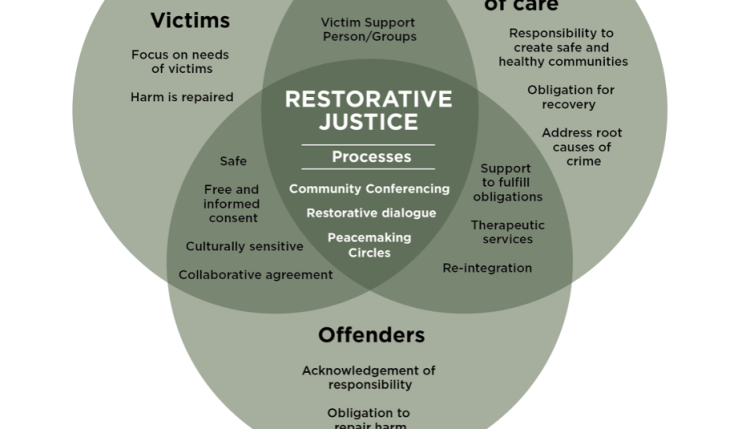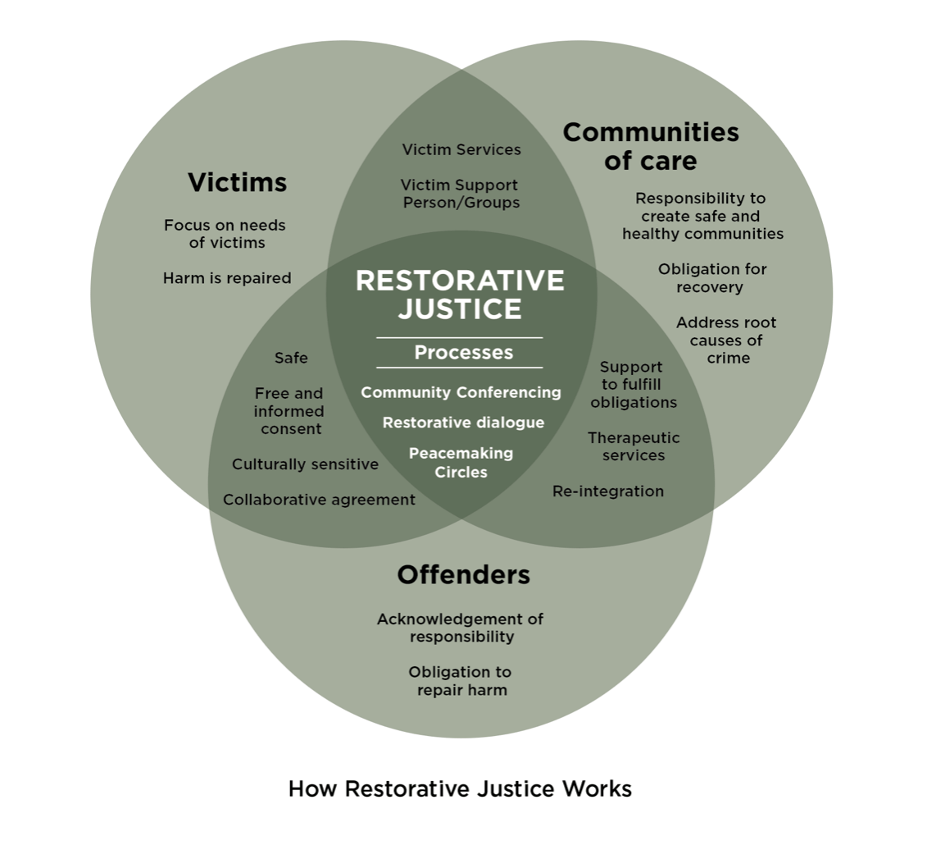
Justice Architecture as an Application of Restorative Justice

In Spring 2023, students in WWU’s ENVS 499D: Readings in Environmental Justice are learning about the intersections between environmental justice and incarceration. This post reflects some of the group’s learning and discussion
By Shirley Zhou, Mallory Schaefbauer, & Natalie Harris
In Deanna Van Buren’s TedTalk, “What a world without prisons could look like,” she introduces the idea of a restorative justice framework to the U.S. prison system. Restorative justice is defined as a “a system of criminal justice which focuses on the rehabilitation of offenders through reconciliation with victims and the community at large” (Oxford Languages). This is often done through a process where the victim and the offender will engage in some form of communication or process, facilitated by a mediator, to address the harm and how it may be repaired (University of Wisconsin Law School). The diagram above illustrates the process and relationships addressed using a restorative justice framework. Rather than focusing on a violation of a rule or law, restorative justice seeks to explore the violation of human relationships when a criminal act is committed (University of Wisconsin Law School). The United States is the global leader in the number of people incarcerated with over 2 million people incarcerated across federal, state, local, juvenile, and immigration detention facilities (Sawyer & Wagner, 2023). Of those incarcerated, drug offenses account for over 350,000 people imprisoned (Sawyer & Wagner, 2023). About 38% of people incarcerated are Black despite only accounting for 13% of the U.S. population (Prison Policy Initiative). This not only calls into question the large disparity in incarceration of Black Americans, it also shines a light on the duration of imprisonment for minor offenses.
Van Buren’s approach seems to fulfill a need for less excessive punishment. Too often, people are incarcerated for long periods of time for crimes which were small, did not harm others, or they are wrongfully charged in the first place. However, in our class discussion, there was some concern about the restorative justice approach in other cases, particularly ones where there was intent to harm, especially sexual assault and violent crimes. Would a restorative justice approach work in this case? Perhaps there is still some need for incarceration in a more just way. Because of this, students had concerns about the way Whatcom County might integrate such a system in the future. While there is a need for a more just approach to incarceration in our county and the United States as a whole, we must be intentional and thoughtful in the way we use it. A few students suggested a supplementary approach, where restorative justice tactics are used only in the case of certain offenses, and would also be used for currently incarcerated individuals. Additionally, we discussed the necessity of taking a gentle approach which recognizes that victims were harmed so that they can also receive grief and trauma counseling, and does not necessarily appear that the crime is excused or the perpetrator is being prioritized. Other feasibility aspects were discussed in terms of logistics, but we felt that voters in Whatcom County would be positively responsive to a gradual integration of restorative justice. All other benefits aside, restorative justice is simply a more cost effective approach to dealing with crime.
Throughout the quarter, ENVS 499D has touched on a variety of aspects surrounding the intersection of environmental justice and carceral justice. Topics ranging from organized efforts made by incarcerated people to toxic living quarters within jails and prisons have been explored. Restorative justice fits within many facets; one topic of discussion prior to restorative justice was jail alternatives; we discussed the new crisis center being built in Whatcom county. This in and of itself is a form of restorative justice in our home county.
References
Initiative, P. P. (n.d.). Race and ethnicity. Prison Policy Initiative.
Oxford languages and google – English. Oxford Languages. (n.d.).
Sawyer, W., & Wagner, P. (n.d.). Mass incarceration: The whole pie 2023. Prison Policy Initiative. .
School, U. of W. L. (n.d.). UW Law Home. About Restorative Justice | University of Wisconsin Law School. .
What is restorative justice?. RJ Pilot. (2022, March 17).